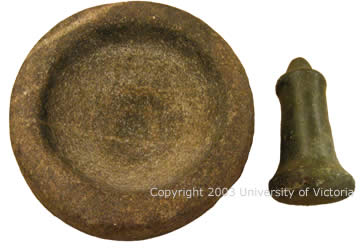| These stone pieces were used up and down the Northwest
Coast for a number of functions including the creation of the pigments
required for painting masks, bentwood boxes, feast dishes and a host
of other objects. The stone mortars and pestles were used to grind
the pigments of natural ochres and mineral clays. They were also used
to crush roasted fungi for pigment and mash berries for the juice.
In obtaining bone black the burned bones would be ground to a powder
in one of these mortars and then combined with a proteinaceous binder
made from salmon eggs. A certain "red stone" was also fired
and then ground by a mortar and pestle such as this ultimately yielding
a black pigment. Another "red rock" quarried on the coast
yielded a red pigment when ground. The stone mortars and pestles were
also specifically used to mix paints, even once commercial pigments
themselves were available. By the 19th century pigments were often
mixed in the mortar with fish oils or even linseed oil for binder.
In addition to paint preparation and mixing, these mortars and pestles
were used in a vast array of food and medicinal preparations with
everything from roots, leaves and berries to bones and fish being
utilized. |







